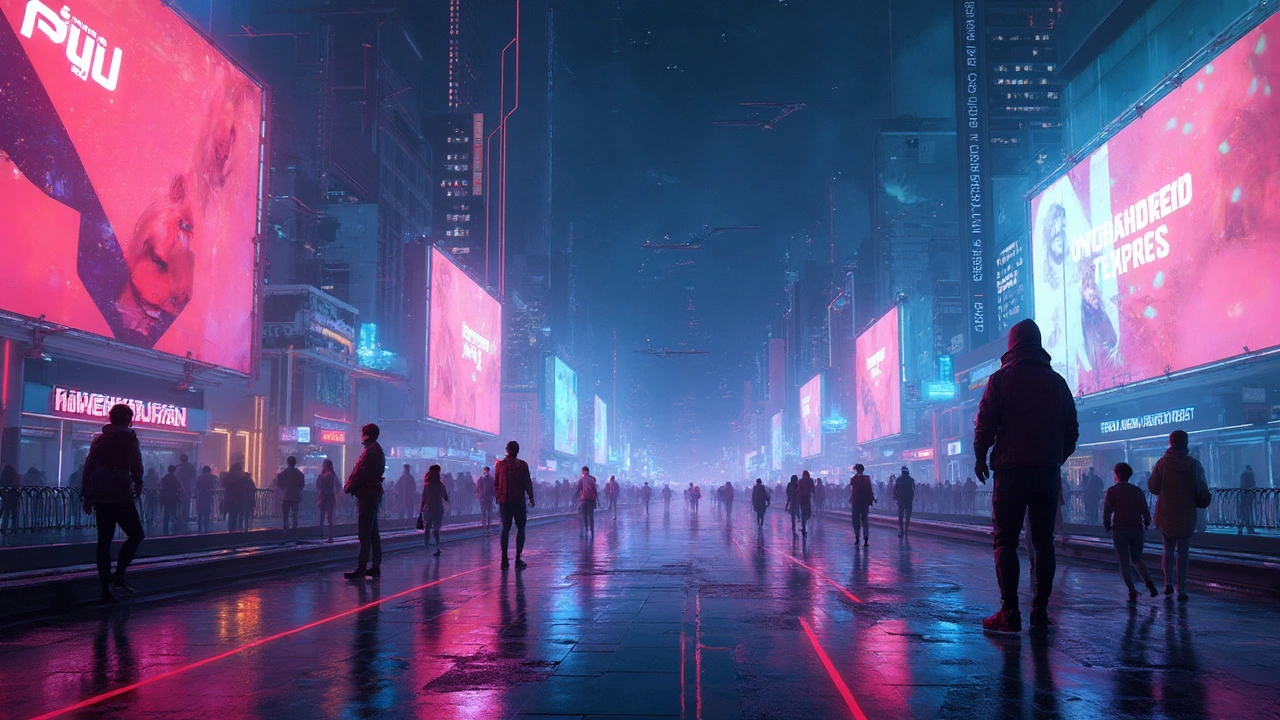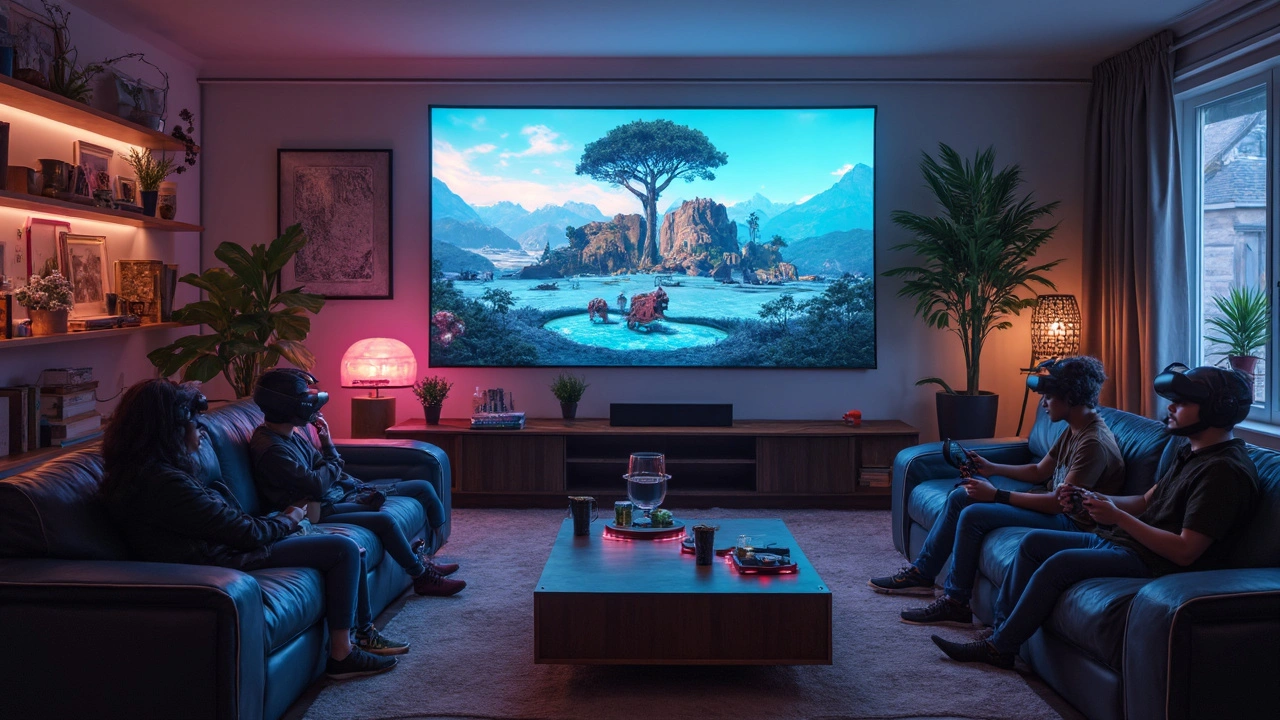The Evolution of In-Game Advertising: What's Next?

Alright, let's dive straight into what's buzzing in the world of in-game advertising. Just a decade ago, seeing an ad in a video game was like finding a coin in your couch—unexpected but not unwelcome. Fast forward to today, and in-game advertising is as much a part of the experience as the gameplay itself.
You're not tripping over virtual billboards or pop-up ads mid-game anymore. Nope, now brands sneak into your gaming life like a trusty sidekick you never knew you needed. Ads blend with the environment—picture sipping a branded beverage in your RPG or driving a car that looks suspiciously like that one from your neighbor's garage.
So, why does this matter? Because the way ads weave into gaming matters to everyone—players, developers, and advertisers. It's all about striking that sweet spot where the in-game ad feels more like an Easter egg than an eyesore.
- A Quick History of Game Ads
- Why In-Game Advertising Works
- Current Trends Shaping the Industry
- Challenges Faced by Developers and Advertisers
- Technologies Revolutionizing In-Game Ads
- What’s on the Horizon for Game Advertising
A Quick History of Game Ads
The world of in-game advertising saw its origins way back in the late 1970s and early 1980s. Donkey Kong, one of the first to sprinkle in some subtle branding, set the stage by featuring the real-life Chiquita Banana Company. Those early days had brands testing the waters with simple static ads, typically as billboards or background elements.
As we rolled into the '90s, sports games caught on. Titles like FIFA and Madden integrated ads as part of their virtual stadiums. These were designed to mimic real-world venues, making ads feel right at home, which wasn't just eye-catching but created a unique opportunity for digital marketing. Players felt connected to the real-life sports universe while they gamed.
The Internet Changes Everything
With the rise of online gaming in the early 2000s, opportunities exploded for developers. Dynamic ads that could be updated instantaneously became possible. I mean, think about it—the same game you had yesterday might serve different ads today. This capability supercharged the whole gaming ads scene, pulling traditional advertisers into the digital world.
Remember America's Army, the game launched by the U.S. Army in 2002? It wasn't just a game but a recruitment tool, showcasing how in-game experiences could carry messages beyond mere product placements.
Into the New Millennium
Fast forward to today, ads have evolved from being an afterthought to becoming an integral part of game design. Brands are now more involved in the development process to ensure their presence is seamlessly integrated. It's not just about slapping a logo on a virtual wall anymore.
- Modern games offer branded virtual items, from clothing to cars.
- Some ads provide exclusive in-game content, offering real value to players.
Thanks to advanced game development technologies, these ads are smoother and feel integral to the gaming universe—a far cry from those early pixelated billboards!
Why In-Game Advertising Works
When it comes to in-game advertising, the magic lies in its subtlety and integration. Games aren't just about high scores anymore; they've evolved into full-blown worlds where players spend a significant chunk of their day. This sets up a prime real estate opportunity for digital marketing in ways that TV spots and traditional ads just can't compete with.
Consider this: unlike passive ad consumption in other mediums, in-game ads are interacted with. Imagine driving past an ad for a car within a racing game – it’s not just a visual; it’s a potential test drive. This kind of interactivity enhances recall and engagement, making ads memorable without being intrusive.
The Role of Immersion
Games offer an engaging escape from reality, creating a perfect canvas for advertisers. Brands achieve immersive integration by replicating real-world interactions. It feels natural to encounter ads in a bustling game city or on a virtual TV. This seamlessness means players hardly notice – and that's the whole point.
Dynamic and Targeted Content
With the growth of data analytics, ads in gaming are moving toward personalization. Developers can serve ads that resonate with players' demographics and preferences. For example, if a player frequently chooses sports game titles, they might see more sports-related ads – pretty neat, right?
Dynamic content is another ace up the sleeve. Unlike static ads, dynamic ones can swap in and out, updating in real time based on current events or trends, making them relevant and timely.
Audience Reach and Engagement
The gaming audience isn't just massive—it's diverse. Gamers span age groups, genders, and backgrounds, offering advertisers a sprawling spectrum of potential customers. Plus, gamers aren't just 'watching' ads; they're up close and personal with them for longer durations. On average, players spend about 7 hours a week gaming, which boosts exposure levels significantly.
Current Trends Shaping the Industry
Alright, let's dissect what's buzzing in the in-game advertising world right now. There's a lot happening, and it's as dynamic as the latest AAA game release. Brands and developers are always on the lookout for that next big thing to keep players engaged without ruining the fun.
Integrated and Seamless Advertising
Gone are the days of static, boring ads. Advertisers want players to feel like the ads are part and parcel of the game. Take sports games, for example. You've likely noticed those digital billboards flaunting real-world brands, right? They're not just there for decoration; they mimic the real sports experience, making the game more immersive.
Interactive and Reward-Based Ads
Players love rewards—who doesn't like freebies? Interactive ads that offer rewards like extra lives or in-game currency are hot right now. They engage the player without feeling intrusive. It's a win-win: players get a little something extra, and advertisers grab attention.
Personalized Ad Content
Personalization is the magic word. With advancements in AI and data analytics, ads can now be tailored to individual players based on their gaming behavior and preferences. So if you're a sucker for racing games, don’t be surprised if you start seeing ads for the latest sports car.
Augmented Reality (AR) and Virtual Reality (VR) Ads
AR and VR are no longer just sci-fi fantasies—they're shaping the gaming industry and how ads are delivered. Imagine putting on your VR headset and seeing a product just an arm's length away, or using AR to place that new couch in your virtual living room. These styles of ads are super interactive and engage users in a way traditional ads couldn't even dream of.
Real-time and Location-Based Ads
With mobile gaming on the rise, real-time location data lets advertisers push ads that are relevant to where you are. Strolling past your favorite coffee shop? You might just get a notification about a deal right there in your game.
Ad Revenue and Player Experience
Of course, the balance between pushing ads and not annoying players is crucial. Too many ads and players might just drop the game, but the right balance keeps them hooked while also generating revenue. A fine line, but those who walk it successfully will keep everyone happy.
In today's gaming landscape, these trends aren't just shaping the way we see ads—they're changing how we experience our games. And as tech keeps evolving, we can only expect in-game advertising to get even more engaging and personalized.

Challenges Faced by Developers and Advertisers
Getting in-game advertising right isn’t just about slapping a logo onto a virtual wall. Developers and advertisers face a slew of challenges when implementing in-game advertising. Balancing the monetization goals with gamers' experience is often the biggest hurdle.
Preserving Player Experience
Gamers can be picky, and rightfully so. They're looking for immersive and uninterrupted experiences. An ad that feels out of place or too intrusive can ruin that. Developers need to think like a director—they have to ensure that ads blend into the scenery and feel like a natural part of the game world. The danger? Ads that pull the player out of the mission and back into reality.
Measuring Effectiveness
It's not enough to just stick an ad in a game and hope for the best. Advertisers need to see real results. How do you measure if a player who saw a banner actually felt connected enough to engage with a brand later on? Often, the metrics used in traditional advertising don't translate well in gaming. Sophisticated analytics tools are necessary but getting accurate data can be tricky.
Ad Blocking and Player Pushback
No one loves ads. And gamers—especially savvy ones—are among the first to push back. Players may resort to ad-blocking tech or mods to strip ads out of games altogether. This anti-ad sentiment can spook advertisers who feel like they're working against the current.
Technical Integration
Seamlessly integrating ads into a game without bugging the game itself is a tech puzzle. Games are complex pieces of software, often with their own resource burdens. Adding ad components without affecting performance requires real engineering skill. Plus, developers have to consider every platform out there, from PCs to consoles to mobile devices.
| Challenge | Description |
|---|---|
| Player Experience | Ensuring ads blend with gameplay |
| Ad Effectiveness | Accurately tracking engagement |
| Ad Resistance | Players blocking or avoiding ads |
| Tech Integration | Ads working across different devices |
Advertisers and developers are in a constant dance, trying to innovate without stepping on each other’s toes. This balance is crucial for making in-game advertising work, and as technology advances, it looks like the dance floor is only getting more crowded.
Technologies Revolutionizing In-Game Ads
In-game advertising has come a long way, and it's mostly thanks to some pretty cool tech making it all possible. Let’s break down the gadgetry and wizardry that’s bringing in-game advertising to the next level.
1. Artificial Intelligence (AI) and Machine Learning
AI is not just for robots and sci-fi flicks anymore. In gaming, it's the secret sauce that helps personalize ads. Imagine the game knows you better than your pet, adjusting what ads you see based on your play style and interests. Brands love it because it hits the target audience spot-on, making ads feel more like content than interruptions.
2. Augmented Reality (AR)
Remember the days when ads were just images? With AR, they come to life right in your living room. Games using AR can superimpose branded items into real-world settings via your device camera. It's like the game world spills over into your real world, making ad interaction super direct and engaging.
3. Programmatic Advertising
This is the tech that's basically matchmaking for ads. Programmatic advertising uses data to find the best ad for the right player at the ideal moment. No more generic ads. Now, it’s all about real-time bidding, where ads are customized and delivered in a flash.
4. Blockchain Technology
Okay, so blockchain sounds buzzwordy, but hear me out. It's revolutionizing digital marketing in games by adding transparency. Players know they're not being spied on, and brands can make sure their ads aren’t getting lost in cyberspace but reaching the right eyeballs.
5. Real-time 3D Rendering
This tech makes ads look amazing by ensuring they fit perfectly into the game graphics. No more out-of-place billboards. Everything blends smoothly, making ads less obtrusive and more a part of the game.
Each of these technologies brings something fresh to the table, ensuring that in-game advertising isn’t just about slapping an ad on a virtual wall but crafting an experience that resonates with players while keeping brands happy.
What’s on the Horizon for Game Advertising
Alright, folks, let's talk about where in-game advertising is headed in the next few years. If you're thinking it's going to be just more of the same, think again. We're on the brink of some exciting shifts that could change how we think about ads in our favorite games.
Personalized Ad Experiences
The future's all about personalization. Game developers and advertisers are teaming up to deliver ads that are not just relevant but tailored to the individual player. Imagine walking through a game world where the billboards and products you see are picked just for you, based on your in-game actions and preferences. This means a more seamless and less intrusive ad experience.
Increased Interactivity
Next up, interactivity. Ads will not just be static images or simple pop-ups. We're talking about ads you can interact with. Imagine an ad that’s more like a minigame or a quest. It’s not there to distract you; it’s part of your adventure. It's like a game within a game, but sponsored.
Virtual and Augmented Reality
Virtual Reality (VR) and Augmented Reality (AR) are game changers, literally. As more players get into VR and AR games, expect ads to become more immersive and integrated. You'll find yourself in a space where ads practically jump out at you—like trying on virtual shoes or walking through a sponsored virtual event.
Dynamic Content
Static ads aren't cutting it anymore. Dynamic content is where it's at. This means ads in games can change in real-time based on various factors like the player’s location, the time of day, or ongoing sports events. Imagine a sports game where virtual billboards update with scores from real-world games while you're playing.
AI and Machine Learning
Artificial Intelligence will play a big role too. Through machine learning, ads can become smarter and more predictive. This tech will help refine which ads players see, ensuring they’re more relevant and well-timed. Basically, it's all about enhanced targeting, making sure players see what actually interests them.



